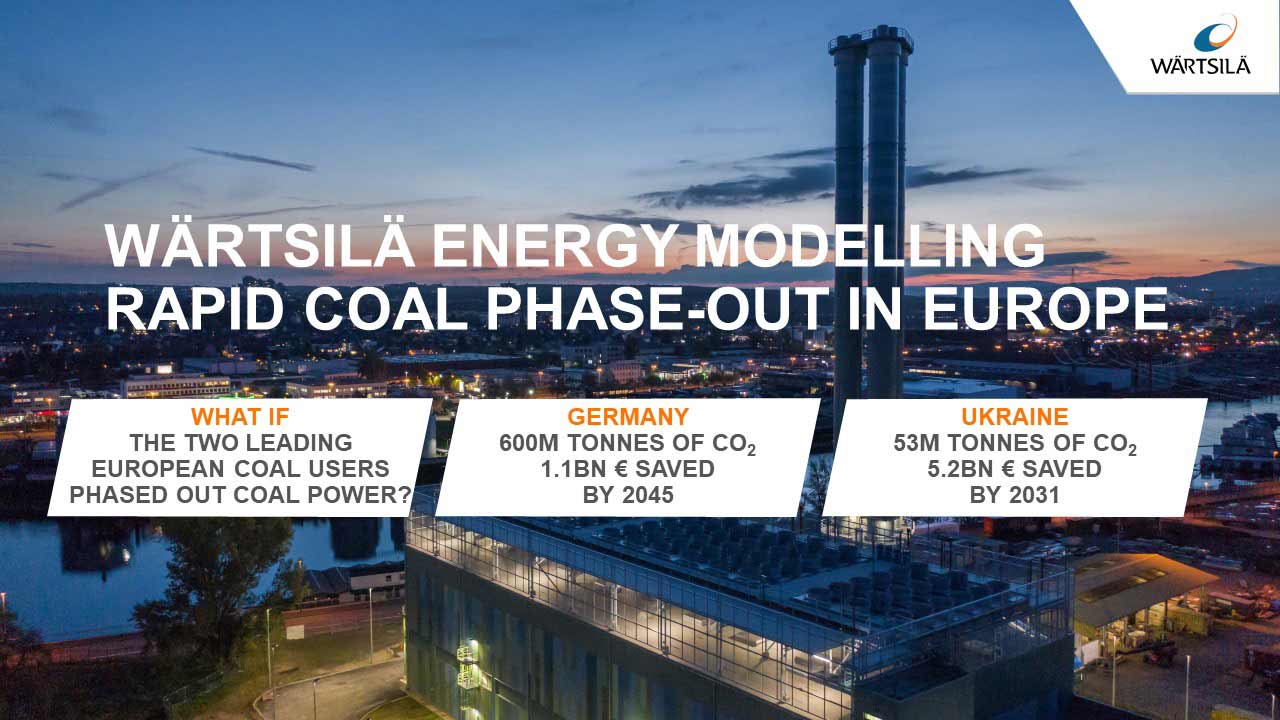

Phasing out coal is critical for Europe to reach its net zero targets by 2050. At present, the European coal exit is at a crossroads.
“The next few months will decide whether European countries can turn the risk of phasing out coal into an immense opportunity,” says Jan Andersson, Market Development Manager, Growth & Development, Wärtsilä
Energy.
Modelling conducted by Wärtsilä Energy shows that European power producers could achieve major system-wide benefits by rapidly replacing coal with renewable electricity coupled with flexible resources such as flexible power plants and energy
storage.
“Rapidly replacing coal with renewables and flexible resources would enable European countries to cut production costs, unlock efficiency, and create new revenue through sector coupling across society,” notes Igor Petryk, Market Development Director, Wärtsilä Energy.
A model for accelerated coal exit in Germany
To date, Wärtsilä Energy has conducted power system modelling for over 80 countries around the world using PLEXOS power system optimisation software.
To showcase how the capacity gap from retiring coal can be met cost optimally in different countries, Wärtsilä took a closer look at two European countries with very different energy systems and policies for phasing out coal power: Germany and Ukraine.
For Germany, Wärtsilä modelled a ‘Fast Phase-out 2030’ scenario, in which coal-fired power would be eradicated by 2030 – eight years earlier than planned. The analysis reveals that the cost optimal scenario for Germany to eliminate coal power would be building 13 GW of new renewable capacity annually.
“The additional renewables would cut Germany’s energy dependence on neighbouring countries during the coal phase-out years, generating a net of 650 TWh of excess, exportable renewable power between 2033-2045. This is 30% more than Germany’s own annual native load of around 500 TWh,” says Andersson.
Andersson confirms that additional renewable baseload would help Germany remain a net exporter of energy throughout the coal phase-out process – and ensure that it does not become dependent on neighbouring countries.
“Accelerating coal phase-out and increasing the speed of the renewable electricity build-out could save Germany up to 600m tonnes of CO2 by 2045. Based on current carbon prices, phasing out coal by 2030 could potentially also allow Germany to avoid 1.1 billion euros a year in emission costs,” Andersson adds.
Wärtsilä’s analysis also shows that unlike many assume, coal exit would not require a major swing to natural gas.
“I have seen reports claiming that 18 GW gas-fired capacity is needed in Germany to counterbalance phasing out coal by 2038 and nuclear by the end of 2022. Our Germany modelling shows that by optimising the system and focusing on renewable energy sources, Germany only needs to build 14-15 GW of new gas by 2030. Yes, extra gas would be required in the medium term – but installing flexible Combined Heat and Power plants, CHPs, decreases the need for new capacity,” Andersson explains.

Should Ukraine modernise or retire its coal?
When it comes to phasing out coal, cost is a major question for Ukraine. Unlike Germany, Ukraine cannot currently incentivise its coal exit. Therefore, it is paramount for the country to find the most affordable path to cleanly meet power demands.
In upcoming months, Ukraine must make a fundamental choice: to either retire coal completely to meet its national emission reduction targets – or simply mend its existing coal power stations and even use them to balance renewables. Wärtsilä modelled the outcome of both options.
“While we examined the business case for phasing out coal in Ukraine, we focused strongly on affordability, to determine what the most economically viable option would be for the country to meet its obligations towards the EU under the National emission reduction plan,” Petryk describes.
Wärtsilä’s analysis gave a very clear-cut answer: modernising Ukraine’s coal power stations would be 10% more expensive for consumers than retiring and replacing the native load with renewables and flexibility.
“Ukraine’s youngest coal power station was built in 1980 – and the rest of the fleet is much, much older. Over 10 years, the cost of modernising would be as much as 5.2 billion euros more expensive than phasing out coal power plants,” Petryk underlines.
Moreover, if Ukraine retires and replaces coal with a mix of low carbon technologies between 2022 and 2031, it will emit 53 million tonnes (32%) less CO2 than it would if the choice is made to merely modernise current coal power stations.
“Investments into renewables, energy storage, and balancing solutions would lead to system-level cost savings for Ukraine. A new cost optimal system, based on 32 GW of new renewables and flexibility, would save Ukraine 500 million euros annually by 2031,” Petryk points out.
Energy independence is also an extremely important issue for Ukraine.
“There are many misconceptions when it comes to Ukraine: that it would have a self-sufficient coal supply, or that gas would be a very scarce resource in Ukraine. Neither is true. Our study shows that the optimal solution for Ukraine is building the base load generation from renewables – and using domestic or European gas as a balance to provide flexibility,” Petryk affirms.
Coal has no room in our future energy mix
Andersson and Petryk concur that Wärtsilä’s analysis from both sides of the coal exit spectrum is clear. As renewables have become the cheapest form of electricity production, the value of coal-fired power has been eroded.
“Replacing coal with renewable assets is akin to purchasing unlimited power up-front from predictable, minimal maintenance assets – and in the not-so-distant-future, excess renewable power can also be used to produce green hydrogen and other carbon neutral future fuels,” Andersson remarks.
“Coal has no room in our future energy mix. In Europe, clean renewable power now has priority access to grids, whereas prices for coal-fired power have more than doubled during the last year. Sticking to coal-fired power production means betting against fluctuating fossil fuel and carbon prices – not to mention dealing with ever-expanding regulation,” Petryk continues.
Andersson and Petryk remind that flexible resources are a prerequisite to reaping the full benefits of coal exit.
“With adequate balancing solutions like energy storage and thermal balancing, countries phasing out coal can not only manage renewable variability, but also drive clean profit,” Petryk says.
“A flexible renewable baseload provides numerous system-level benefits, for example storing excess electricity in batteries, charging electric vehicles, and cleanly powering district heating systems,” Andersson concludes.